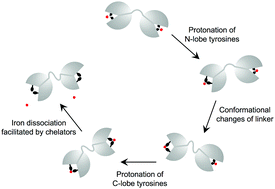Computational approaches for deciphering the equilibrium and kinetic properties of iron transport proteins
Abstract
With the advances in three-dimensional structure determination techniques, high quality structures of the iron transport proteins transferrin and the bacterial ferric binding protein (FbpA) have been deposited in the past decade. These are proteins of relatively large size, and developments in hardware and software have only recently made it possible to study their dynamics using standard computational resources. We review computational techniques towards understanding the equilibrium and kinetic properties of iron transport proteins under different environmental conditions. At the level of detail that requires quantum chemical treatments, the octahedral geometry around iron has been scrutinized and it has been established that the iron coordinating tyrosines are in an unusual deprotonated state. At the atomistic level, both the N-lobe and the full bilobal structure of transferrin have been studied under varying conditions of pH, ionic strength and binding of other metal ions by molecular dynamics (MD) simulations. These studies have allowed questions to be answered, among others, on the function of second shell residues in iron release, the role of synergistic anions in preparing the active site for iron binding, and the differences between the kinetics of the N- and the C-lobe. MD simulations on FbpA have led to the detailed observation of the binding kinetics of phosphate to the apo form, and to the conformational preferences of the holo form under conditions mimicking the environmental niches provided by the periplasmic space. To study the dynamics of these proteins with their receptors, one must resort to coarse-grained methodologies, since these systems are prohibitively large for atomistic simulations. A study of the complex of human transferrin (hTf) with its pathogenic receptor by such methods has revealed a potential mechanistic explanation for the defense mechanism that arises in evolutionary warfare. Meanwhile, the motions in the transferrin receptor bound hTf have been shown to disfavor apo hTf dissociation, explaining why the two proteins remain in complex during the recycling process from the endosome to the cell surface. Open problems and possible technological applications related to metal ion binding–release in iron transport proteins that may be handled by hybrid use of quantum mechanical, MD and coarse-grained approaches are discussed.

- This article is part of the themed collection: Recent Review Articles


 Please wait while we load your content...
Please wait while we load your content...